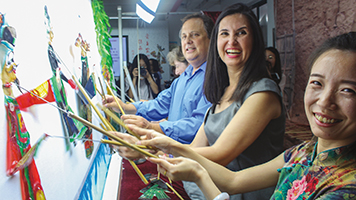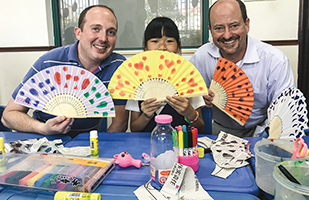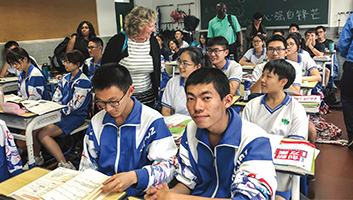
|
From left, Dion Betts, an assistant superintendent in the School District of Philadelphia, and Lupita Hightower, superintendent of Arizona’s Tolleson Elementary School District, with a host Chinese educator, participate in a traditional Chinese shadow puppet theater during their overseas trip.
|
Lupita Hightower didn’t know what to expect when she landed in China. The superintendent of the 3,000-student Tolleson, Ariz., Elementary School District arrived in the country a week early to do some digging into her family’s history. She knew that her great grandfather had immigrated to Mexico from China in the late 19th century, but little did she realize she’d end up staying in a hotel in China in the same vicinity appearing in a photo of her forebear that had been handed down to her years ago.
“I was emotional about it,” Hightower says. “You go to Hong Kong — it’s a big city. You could stay anywhere, and I end up staying a block away from where that picture was taken in the 1800s!”
That wasn’t the only thing Hightower found fascinating as a member of the 14-member delegation that visited China for 10 days last July as part of the AASA Discover China program. The participants, including five superintendents, observed classes in elementary and secondary schools, delivered presentations on distinctive aspects of their school districts back home and discussed issues of common interest with officials from local and state education departments in Shanghai, Beijing and Nanjing, three major cities located nearly 800 miles from one another.
“It was great to be able to present and then listen to the presentations from our colleagues,” Hightower says. “During a presentation from Wang Dinghua from the Beijing Foreign Studies University, who spoke at a high level about the education system in China, I was hanging on to every word! He was remarkably open on the successes and challenges of education in China. We could see the incredible things that are happening in their school districts and also learn from a different system.”
Value of Visits
Learning practices and policies from a markedly different system of schooling is exactly why trips like this one are essential for the future well-being of the American education system, according to Marc Tucker, president and CEO emeritus at the National Center on Education and the Economy. From student performance on the Program for International Student Assessment to the structure of the teaching career, he says, several reasons compel American educators to pay attention to the Chinese education system.
“We tend to think if you visit a school somewhere else in the state or even somewhere else in your school system, you’re learning something really important, but the fact is, the United States is far behind these other countries,” contends Tucker, editor of
Surpassing Shanghai: An Agenda for American Education Built on the World’s Leading Systems. “There are very good things happening in the United States, but they’re happening in a relatively dysfunctional system. If you want to see a whole system functioning at a high level, you have to leave this country.”
Particularly in Shanghai, Tucker points to the 16-step career ladders that teachers climb to gain expertise in their field “that have no parallel in our country.” As teachers move up the ladder, they work with other teachers to systematically improve the curriculum. (“It doesn’t mean they are team teaching,” Tucker cautions.) Teachers in China get to know their students such that they help with problems inside the classroom and out and prioritize their own skills as team leaders.
Eye-Opening Commitment
The focus on assessments was obvious to Hightower, who signed up for the overseas mission hoping to observe how Chinese students rate so highly on international exams. When her group encountered high school students who were in school for 12 to 15 hours a day during the summer to hone their skills for the Chinese equivalent of a senior-year examination before going to college, she admits she was surprised, but notes she saw a social-emotional component in the Chinese system as well.

|
Michael Donnelly (left) an administrator in Pennsylvania’s Palisades School District, and Dave Baugh, superintendent of Centennial School District in Warminster, Pa., show off the fans they made with help from a host Chinese student during the AASA Discover China trip in 2018.
|
“Of course, they care about the scores, but they also care about the students’ emotional well-being,” Hightower says. “They would like it to be more like American schools and they feel the social-emotional well-being of the students has to be considered.”
Aspects like social-emotional learning and a focus on STEAM subjects in the Chinese schools led to a reaffirmation of sorts for Kathleen Cuddy-Egbert, superintendent of Governor Wentworth Regional School District in central New Hampshire. As she toured schools, she found her 2,400-student district already is doing some things her Chinese counterparts hope to do.
“The Chinese educators talked to us a lot about American education really being something they aspire to become more like — big emphasis on STEM, on becoming more creative and innovative and on critical thinking and problem solving,” Cuddy-Egbert says. “It confirmed that the United States, particularly educators, not politicians, are going in the right direction in the things we’re trying to accomplish.”
Cuddy-Egbert, who is in her sixth year as superintendent, wanted to use the trip to develop relationships with Chinese schools and put some feelers out for potentially inviting some Chinese students to attend schools on a tuition basis in Governor Wentworth. While that’s a work in progress, she says three of her elementary schools are partnering with sister schools in China.
“We’re a homogenous population up in the lakes region of New Hampshire, so I think exposure to different cultures is pretty important, and they don’t get that in their day-to-day schooling,” Cuddy-Egbert says. “They had a saying (in China) that I think says a lot that they want to inspire global thinkers with a Chinese heart, which I thought was very interesting.”
Reciprocal Excursions
Exposure to foreign educators on their home turf sometimes leads to follow-up consultations back home. Cuddy-Egbert, upon her return, ordered a book written by a Pennsylvania administrator she met on the trip, and she has invited him to meet with faculty and staff in her school district later this year.
Michael Donnelly, as well, has invited Chinese educators to visit his district. The 2018 AASA Discover China trip was the second in as many years for Donnelly, who is the director of curriculum, instruction and assessment of Pennsylvania’s 1,500-student Palisades School District, about two hours north of Philadelphia in Bucks County.
After returning from his first excursion to China in 2017, he hosted a contingent of approximately 50 educators from China last January in his school district and the nearby Centennial School District, where he previously worked as a principal.
Using what he learned as a host, he took on more of a consultant role during his second Discover China trip in July to assist in the on-site logistics.

|
The Zhongguancun Middle School in Beijing, China, hosted the American school leaders during the AASA Discover China program.
|
Specialized Discoveries
The 2018 delegation was double the size of the previous year, so Donnelly split the school leaders into smaller groups to explore their particular interests in the Chinese education system. On one day, a group checked out a school serving children in special education while a second group visited a school with a strong arts program.
“That was a great opportunity for them to get to experience and hear about the world of special education in China while the rest of the cohort was able to have a hands-on experience,” Donnelly says. “It was a neat way to divide the group to create those robust experiences for everyone involved.”
By the conclusion of the educational excursion, Cuddy-Egbert, Donnelly and Hightower agreed that Chinese and American education systems are not as different as they may seem at the outset.
“My epiphany was at the end of the day, we really are more alike than different,” says Donnelly. “No matter where we are, whether it’s Washington, D.C., or Beijing, China, ultimately it’s about what we can do that’s best for kids in a growing world.”
JULI VALENTINE is senior editorial assistant of
School Administrator magazine.